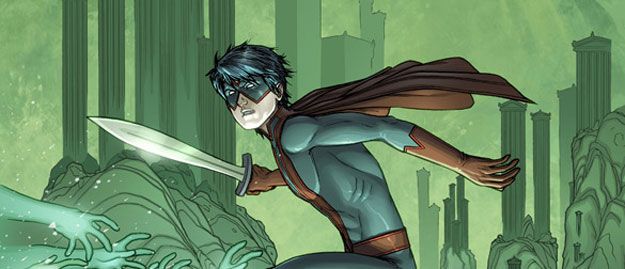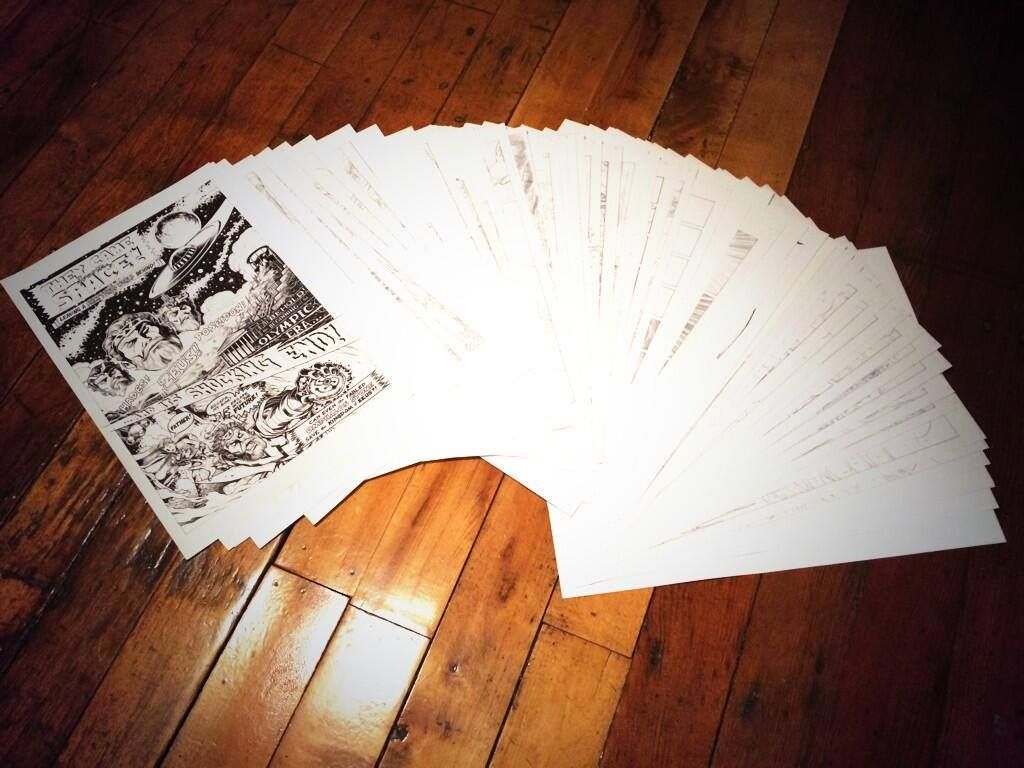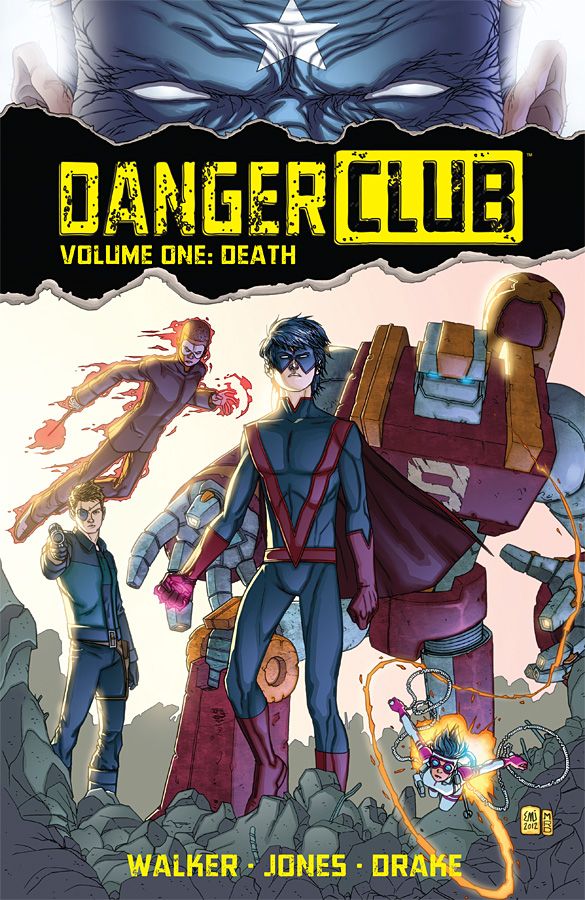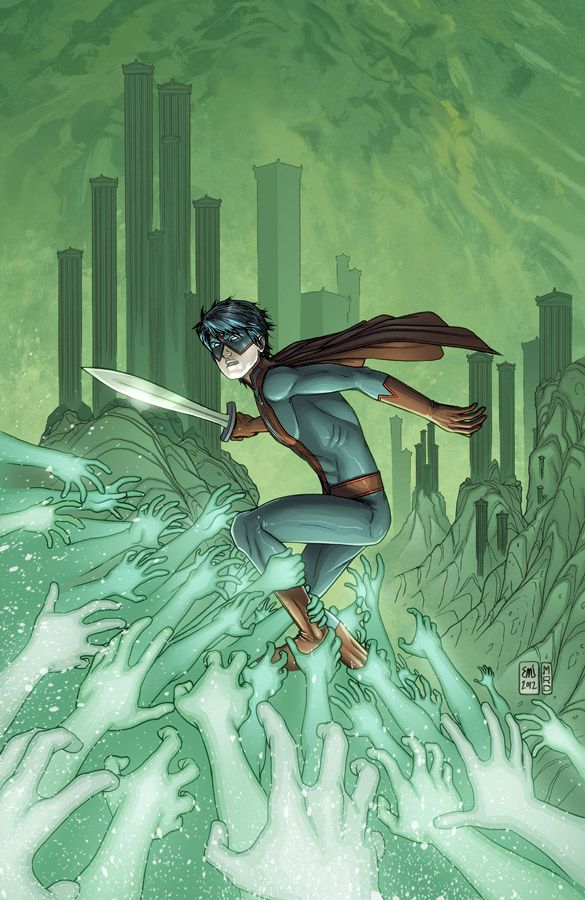Danger Club, the teen-superhero miniseries from writer Landry Q. Walker, artist Eric Jones and colorist Rusty Drake, earned acclaim upon its debut in April 2012 for its blend of classic comic-book archetypes and decidedly darker sensibilities. It's a violent mix of Teen Titans, Watchmen and Lord of the Flies, with young sidekicks -- both heroes and villains -- left to their own devices after their mentors head into space to face a cosmic threat, and then never return.
However, just as the Image Comics miniseries was kicking into high gear, it was derailed by real-world concerns when the fourth issue was delayed after one of Drake's children was struck by a car. That contributed to a domino effect, with Issue 5 arriving in April 2013, after which Danger Club went on hiatus.
However, that changes late this month, when the eight-issue series returns for its final leg: Issue 6 goes on sale Jan. 28, followed by Issue 7 on Feb. 25 and Issue 8 on March 25.
Walker, whose stint as writer on DC Comics' Red Lanterns also begins Jan. 28, spoke with ROBOT 6 about the return of Danger Club, its influences and whether we can expect a return to all-ages fare by the team behind Supergirl: Cosmic Adventures in the 9th Grade.
ROBOT 6: With all the personal setbacks and delays, it must’ve felt at times as if you would never complete Danger Club. How does it feel now that you finally have issues 6 to 8 finished?
Landry Walker: I think I can speak for all of us when I describe it as “liberating.” The book has been tremendously therapeutic to work on, but it’s been several years in the making, and we’re all anxious to turn our attention to other projects – we have several currently in low-grade development.
Can you bring new and returning readers up to speed on the series? Where do things stand as we head into Issue 6?
Kid Vigilante has been shot through the head by his closest friend. Apollo had been killed, resurrected, and killed again. Jack Fearless has been ripped to pieces by his former mentor. The Magician was last seen in search of the lost heroes within an astral dimension. Lady-Bug and Fahrenheit were battling their way through Skybase 1. Yoshimi had assumed control of Micro-Tokyo’s army of Giganto-Bots. The President of the Global United States had just erased all of reality . .. That’s the basics, I think.
By the time the Danger Club #6 arrives at the end of January, it will have been 21 months since the release of Issue 5, which ended on one heck of a cliffhanger. Did you -- do you – worry that readers won’t return to see how the story ends?
No. Not really. I’m told by some people that I should. But why? People will read the book or they won’t read the book. All any of us can do is try and make it the best book we can.
What I do regret is having the previous issues solicited without having the material ready. That is something I can only apologize for. As has been well documented elsewhere, life got in the way. I assure anyone reading this that our projects will be complete before solicitation in the future.
In his introduction to the trade collection, Matt Fraction name-checks Wolfman/Perez-era New Teen Titans and Claremont/Sienkiewicz New Mutants. Clearly, the “team of sidekicks” concept is central to the book, but how much influence did those particular classic runs in have on the creation of Danger Club?
Both series came out during our formative years, so the influence is clear, and Matt was quite right to point to it. On my part, particularly what Wolfman and Perez accomplished with Dick Grayson – I had been a Robin fan since I was three years old. So yeah, that book was impactful on my writing. Very.
You’ve referred to the series as “a commentary on the evolution and history of comics.” Can you expand on that?
Much of that will become clearer as the series progresses. Both Eric and myself worked in a comic store in Berkeley through the early ‘90s and watched the rise and fall of the speculator boom firsthand. It was a strange time, when there were actual discussions at SDCC as to whether writers were needed for comics. This was just a few years after Watchmen and The Dark Knight Returns. It seemed like an absurd question now in a world with Matt Fraction and Ed Brubaker, but look what was happening in comics them. It was seriously alarming -- just as it is alarming now when we see writers given credit above artists. Comics require balance.
You of course utilize teen-hero archetypes and analogs extensively, although some are more easily identifiable than others: For instance, Kid Vigilante/Robin and Jack Fearless/Bucky Barnes. Was there a process for deciding which analogs the story required – was it, “OK, we need a Robin and a John/Zachary Zatara,” or did the characters’ personalities and roles develop first?
The roles came first. Most of the characters are analogous for people we have known – mostly during our teen years. Some of whom are long lost through sickness, suicide or accident. Some of the superhero analogs were intentional, and others were coincidental. Bucky was actually not intended at first, but morphed naturally into the role as we developed the story. He was originally a guy with luck powers who had managed to have most of his body destroyed and survived to be rebuilt into a robot form. It wasn’t until after we developed the American Spirit that we placed Jack in that Bucky-esque role.
We’re thrown into the middle of the action at the very beginning, and only given glimpses into the characters’ pasts through dialogue and the “retro pages” that tease their Silver Age-style adventures. I realize Danger Club ends with Issue 8, but is there a chance you could return to flesh out the backstories? Or, in the off-chance most of the central characters survive, a sequel?
It’s conceivable. We’ve played around with a series that explores the creation of Micro-Tokyo and the rise of the Giganto-Bots. I also really want to do a funny animal one-shot issue with Cat Vigilante, Jack Rabbit Fearless, Mouseshimi-Ittybittyo, the Moogician and so on. I don’t think Eric will draw it, though. Maybe. Maybe if I blackmail him. I bet Rusty would go for it, though. Easiest guy in comics to work with ever.
But examining the need … let’s take what we’ve already established with Jack Fearless. He was a sidekick to a patriot hero in the ‘40s who was blown up by a Nazi bomb. His brain survived in a jar for decades in an old Nazi lab. He’s been rebuilt into a robotic body and now faces his aged mentor in a battle for the sake of the universe. If you look closely, you can see who he has a crush on, and you can then extrapolate a love triangle. That recolors a lot of interactions which ideally adds layers for the reader. We could spell all this out in a massive series all about Jack – but why? It’s already been told with just a couple of pages. Why belabor it? Same with Ivan and his family and his mother’s hatred of superheroes based on her own jealousy issues. It’s all there. The rest is up to the reader.
Long story short: I’m of the “Less is more” school of thought.
The same day Danger Club #6 arrives, your first issue of DC Comics’ Red Lanterns hits the stands. Is this the end of your all-ages work for a while, or do you and Eric plan a return to that territory?
It’s weird it’s coming out the same days as my Red Lanterns issues. I saw one person online suggest it was planned. I’m not sure how we could have planned that one. Anyway, been a while since Eric and I have done any all-ages work together. 2011, I think. We still very much want DC to greenlight Supergirl: Cosmic Adventures in the 9th Grade. Outside of that, whichever of our projects we move forward with next will likely be as different from Danger Club as Danger Club was with our Supergirl book. Change keeps the job more interesting, after all.




